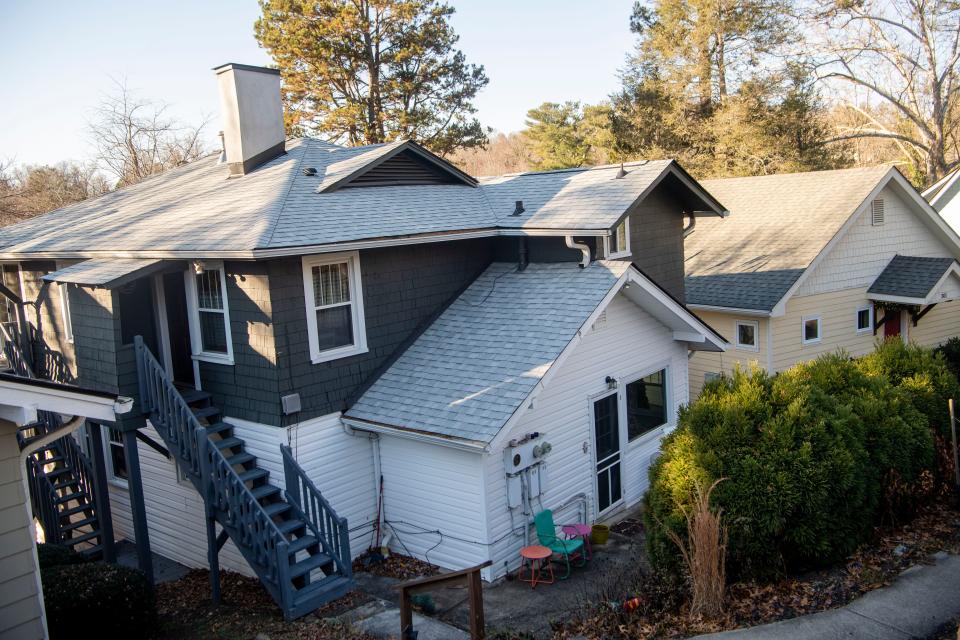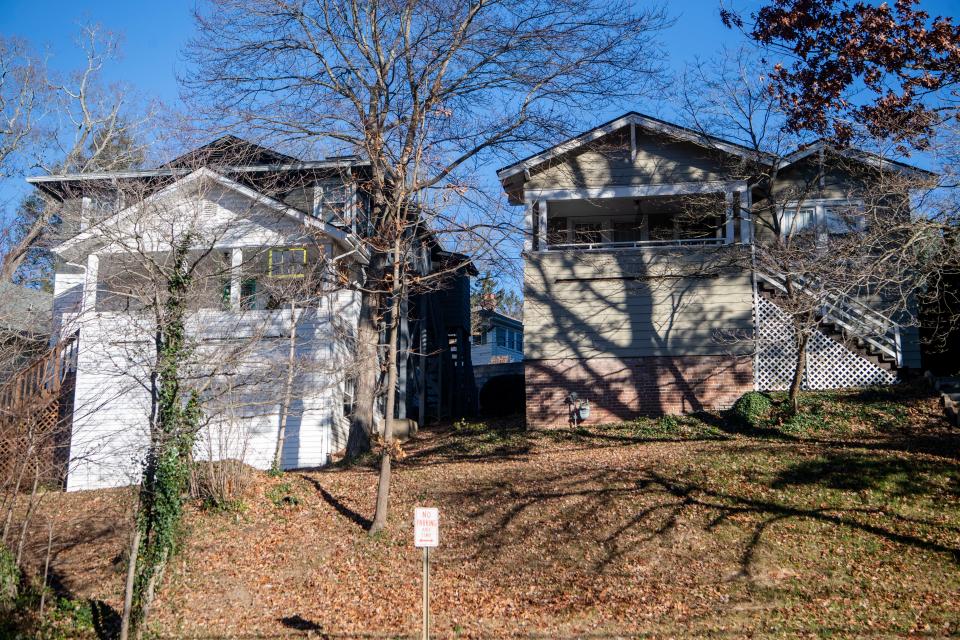'Missing middle': New study pursues more townhomes, duplexes, multiplexes in Asheville
ASHEVILLE - A boxy, brick mid-20th century fourplex. A 1920s two-story house with five mailboxes on its front porch. A blue duplex on Montford Avenue's main drag, once a beauty salon.
It only takes a short walk through the Montford Area Historic District to turn up several examples of the sought-after "missing middle" housing, which developers say is one possible solution to help quell a staggering housing crisis, and findings from a new draft study determined is stifled by regulatory and policy barriers.
Missing middle housing is house-scale buildings with multiple units in walkable neighborhoods, housing types that have been largely missing from the residential housing market over the last 70 years, such as: duplexes, cottage courts, triplexes, fourplexes, multiplexes and townhomes.
These are the housing types that a new $85,000 study, funded in 2022 by Asheville City Council, set out to explore. After six months of research, public engagement and analysis, the draft of the study was released Nov. 17.

'1 answer to our housing woes'
"This may be one of our strongest and most helpful housing studies yet. It dives deeper into our housing typologies and unaffordability, then gives us hope and real suggestions for new policy and strategies," said council member Sage Turner.
She's one of three council members on the city's Planning and Economic Development Committee, which will review the draft study Dec. 11.
Led by consultants California-based Opticos Design and Oregon-based Cascadia Partners, the study found that existing regulations encourage single-family housing significantly more than missing middle housing types, such as those found sporadically throughout the city, largely in its most historic and walkable areas, like Montford.
Like most urban areas built before the 1940s, said the study, Asheville has many examples of missing middle housing types. But as zoning regulations changed, "complicated" and "cumbersome" processes discouraged developers from continuing to build missing middle housing.
"For decades, Asheville has primarily been developed with either single family houses or very large apartment complexes. These limited methods can perpetuate sprawl by growing the infrastructure and maintenance costs of roads and utilities," Turner said in a statement.
"These methods also frustrate residents with new or greater traffic hotspots and sudden, large changes to their neighborhoods. One answer to our housing woes is somewhere in the middle. The missing middle."

More: Study: How much affordable housing has Asheville City Council approved in 10 years?
Developers react
The new housing being built, alongside the existing housing stock, is not keeping up with current and future housing needs in terms of variety of types and price points, the study said.
The study found that the city will need to adjust its zoning standards to allow for more missing middle housing types, but also to further encourage missing middle over single-family development through a simplified entitlements process and incentives.
Developer Barry Bialik, who considers himself among one of the largest missing middle developers in the area, said it's good the study is out there, but that he felt it needs a closer "holistic" look and more vetting, particularly around other barriers.
“We already have the zoning in place to do most of what would be considered missing middle. The problem is that no one is doing it," he said.
From his perspective, it's less about zoning, and more "everything else," like the process itself, infrastructure, stormwater regulations, and rights-of-way, driveway and road standards.
"The devil is in the details," he said. With the help of an advisory working group of local builders, developers and other stakeholders, he hopes the draft study will see further review and create more "concrete recommendations."
'A great roadmap'
Geoffrey Barton, CEO and president of Mountain Housing Opportunities, an Asheville-based nonprofit community development corporation whose mission is to build and improve homes with a focus on affordability, said he's excited about the study, which he called a "great roadmap" toward needed growth and infill.
“The real test is going to be how quickly we can implement some of these recommendations," Barton said. "Asheville needs thousands of housing units, like, 10 years ago. So we’re playing catchup and my hope is we can really start to aggressively implement some of these very sensible recommendations to help create more housing units within our city limits."
More: Asheville seeks solutions for 'missing middle housing': townhomes, duplexes, multiplexes
Between 2010 and 2021 the population of Asheville increased by 12.5% and, notably, housing costs increased by 40%, the study said. By 2040, Asheville is projected to become home to an additional 15,000 residents. To match this population increase, Asheville would require 7,500 new housing units in the next 16 years.
Missing middle units tend to be more affordable than the large, detached single-family homes being built in Asheville, Barton said. Plus, he pointed to the big picture: meeting the commuting challenge. According to the city's comprehensive plan, of its 77,500 employees, only 24% live and work in Asheville.
It's a "huge" amount of commuters, many of which would live in Asheville if there was a suitable housing option, he said. Missing middle is one way to address the "pent up" demand for workforce housing.
What is the missing middle?
Gone are the days of an easily in-reach, single-family home for a middle-income buyer. As Asheville homes price higher than any other large city in the state, the study found that in Asheville, purchase of a large detached home requires a CEO's salary.
It's a tale of two extremes. Residential building permits approved skew heavily toward single-family dwellings. Within the slice of multi-family construction, most are over over 50 units.
Missing middle is the "sweet spot."
It tends to appeal to millennials and baby boomers, both quickly growing demographics in Asheville who are looking for more choices, smaller options and and higher affordability. Missing middle is walkable, ideal for urban infill and compatible with single-family buildings. It achieves "medium-density yields" and provides "high-quality, marketable options" between the seesaw of single-family and mid-rise apartments, the study said.
In Asheville, 47% of renters and 25% of homeowners are cost burdened, meaning they spend more than one-third of their income on housing. There's been a 39% decrease in housing affordability from 2014 to 2023, according to the NAHB/Wells Fargo Housing Opportunity Index.
Ten years ago, the median home sale price in Asheville was $217,000, says data crunched by Mosaic Realty. In 2023, that number had risen to $488,000.
More: Food security in Asheville, Buncombe County threatened by 'socioeconomic perfect storm'
Recommendations?
The study offers dozens of recommendations, ranging from policy and zoning, to implementation. It also included a displacement risk assessment and mitigation strategies to help the city understand where existing residents are most vulnerable to displacement and how to enable missing middle housing while maximizing its benefits and minimizing potential harm.
With recommendations working in tandem with the anti-displacement strategies, Barton said it would help negate impacts to the city's most vulnerable communities, while also providing needed units.
Turner also shouted out recommendations around flag lots, "a current hot topic," and tools for “lot testing," to better understand how each strategy or tool can work in different areas and create new housing without overwhelming neighborhoods.
Barton was excited to see recommendations around reduced parking requirements and incentives to create more walkable communities.
“I think this provides really a very current suite of best practices that I’m hopeful will be a jumping off point for the bigger conversations around (Unified Development Ordinance) rewrites," Barton said. "What I see described in the missing middle study are the types of communities that we’ve been talking about trying to build, but with specific strategies on how to do that."
More: Where does Asheville home price growth rank in U.S.? Hint: pricier than Chicago, Atlanta
More: Debunking homelessness myths: Asheville experts take on 5 common misconceptions
Sarah Honosky is the city government reporter for the Asheville Citizen Times, part of the USA TODAY Network. News Tips? Email shonosky@citizentimes.com or message on Twitter at @slhonosky. Please support local, daily journalism with a subscription to the Citizen Times.
This article originally appeared on Asheville Citizen Times: Study: How can Asheville remove barriers to 'missing middle housing?'

